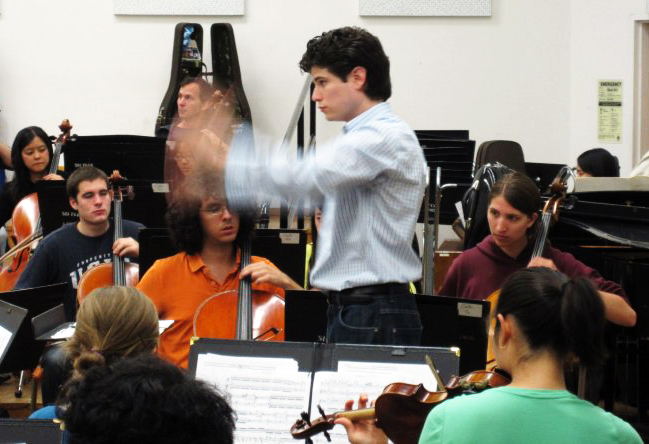UCLA Symphony to tell a story via music in performance

Daily Bruin File Photo
Graduate student Jorge Uzcategui is one of the conductors that will lead the UCLA Symphony as it performs Carl Nielsen’s “Helios” overture among other classical pieces.
UCLA Symphony
Today, 8 p.m.
Schoenberg Hall
By Gillian Hughes
May 30, 2012 2:10 a.m.
Even though there are no words in a symphony concert, graduate student conductors Ryan Dudenbostel and Jorge Uzcategui believe music is a conversation between instruments and can tell a story of triumph.
Dudenbostel and Uzcategui will lead the UCLA Symphony as it performs Carl Nielsen’s “Helios” overture, Ludwig van Beethoven’s “Triple Concerto” and Pyotr Ilyich Tchaikovsky’s “Symphony No. 5.”
Beethoven’s “Triple Concerto” will open the show. Hillary Smith, a graduate music student and cellist in the performance, said that having three soloists rather than one complicates the interaction between the players.
She said it’s especially difficult because of the divided attention the piece requires. The orchestra players have to focus on their part while also listening to the soloists. The conductor’s role smooths and balances the interaction between the two.
Dudenbostel said he looks forward to conducting Nielsen’s “Helios” because many people haven’t heard it before, but he loves the musical dialogue in Beethoven’s “Triple Concerto.”
“There is so much interaction between myself and the three soloists and the orchestra,” Dudenbostel said. “There’s this feedback cycle of musical communication. Of course there aren’t words and of course it’s all written down, but there is that feeling of dialogue.”
According to Smith, the cello’s expansive register ““ its ability to play a large range of notes ““ gives the cello an emotional character that makes it stand out in the performance.
“I love the second movement,” Smith said. “There’s a big cello piece at the beginning and I think it’s the soul of the whole piece. … The rest is pretty active and fun and this is the one moment of the piece where it slows down and it’s pretty expressive.”
Sanaz Rezai, a music graduate student and pianist playing in “Triple Concerto,” said it’s important to watch the piece in addition to listening.
“When you watch you can identify the different instruments and see who the different soloists are and what they’re playing,” Rezai said. “You can learn a lot about the character of the piece just by their expressions.”
Rezai said that performing with the orchestra is like acting because conductors and players have to exaggerate their expressions to parallel the tone of the piece.
For the second half of the show, the orchestra will perform Tchaikovsky’s “Symphony No. 5.” Uzcategui, who will be conducting the piece, said that within its varying tones, a repeated refrain hangs ominously over the performance, only to be defeated with the last movement.
“The first movement is so magnificent, the second movement so melancholic and dramatic, then the third so charming and then of course the last one so majestic,” Uzcategui said. “It’s kind of like the triumph over all this sorrow and pain that we feel throughout two movements.”
Despite the rising pressures of today’s approaching performance, Uzcategui said he remains optimistic.
“We will find a way to make magic (today),” Uzcategui said.


